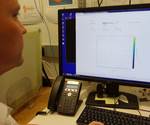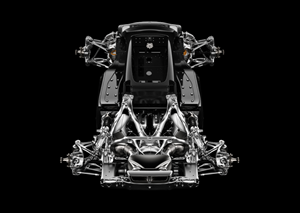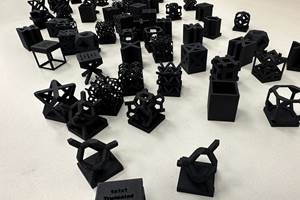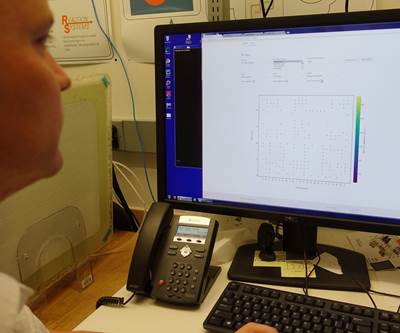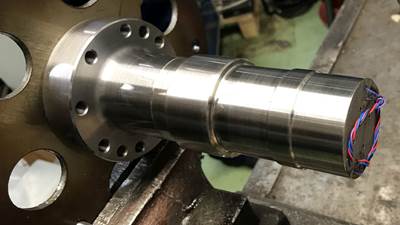AI-Driven Adaptive Manufacturing Software Aims to Self-Correct 3D Printing (Includes Video)
The AI software platform Blacksmith from Markforged shares feedback from its cloud-connected fleet of printers to identify and correct distortions in a 3D-printed part.
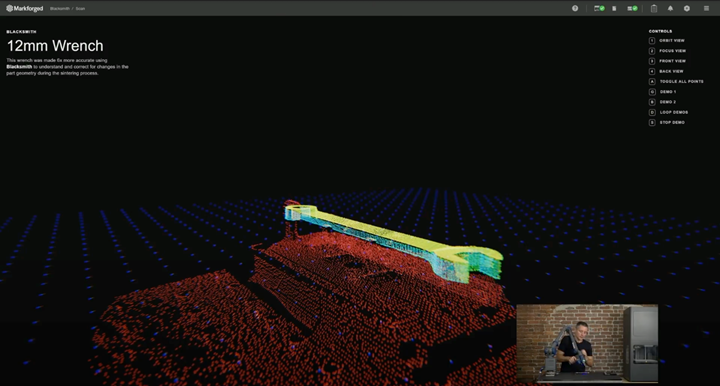
Blacksmith seeks to close the loop in manufacturing by connecting its printers to metrology equipment — used here to scan a 12 mm wrench — to understand and correct for changes in the part geometry that often take place during the sintering process. Learn more in the article and video below.
The path to success for Markforged’s artificial-intelligence (AI) software is much less a path than it is a continuous loop. “Blacksmith” is what Markforged calls an AI-driven software solution for adaptive manufacturing — a process that entails adapting to the myriad variables that affect 3D printing through each step of a part’s design, printing and post-processing.
When companies use 3D scanning to map data points against a part’s original CAD or STL file, deviations between the two often require going back to the original file for adjustment — a time-consuming, inexact science for the best engineers.
David Benhaim, chief technology officer and co-founder of Markforged, told me that by creating a loop between AI, design tools and 3D scan data, Blacksmith will, over time, hasten the ability of the company’s entire installed base of printers to self-correct against variations throughout the printing process. This means that printing a part right the first time will become more likely after the part — or more accurately, after geometry similar to that of the part — has been printed hundreds or thousands of times.
“Over time, if the machine deviates or something in your process or your environment changes, the machine can detect that and alert you or correct itself in real time,” Benhaim says. When Blacksmith is enabled, the company’s composite printers use a laser scanner attached to each machine’s printhead to simultaneously create and inspect a part, then feed that data back into the cloud. This data will allow the self-correction ability to get faster as more and more machines share feedback into the cloud.
Shapes, Not Parts
As we have covered previously, Markforged has made substantial investments toward gaining control over part distortion — especially distortion that takes place inside a furnace during sintering. These investments in observing and quantifying part behavior have led to algorithms that produce pre-distortion geometry — geometry that takes into account the anticipated distortions and counteracts them to produce the expected part.
Through a process resembling the very same fused filament fabrication of the company’s polymer or composite printers, Markforged’s metal printers produce “green” parts composed of metal particles suspended in plastic and wax. These parts are placed into a solvent that removes the first stage of the binding materials, then placed into a sintering oven that burns away the trace amounts of remaining binding material and fuses the metal particles together.
From the initial design file to the finished metal part, there are several opportunities for a part to deviate from its original design through distortion. Material, processing temperature and atmospheric composition all interact in complex ways that Markforged has sought to understand and control.

Blacksmith uploads design files to the cloud for slicing. The system then send the files into a feedback loop shared by a fleet of connected 3D printers to improve each machine’s part accuracy over time.
Benhaim says that Blacksmith is the result of the company’s efforts toward understanding and controlling the end-to-end process for its AM parts. In the example shown in the video below, Benhaim compares feature dimensions from the CAD file to the scanned part of a common wrench: the diameters of the various wrench pieces, as well as their locations relative to each other. While scanning the part, the diameter of the wrench’s holes may be perfectly dialed in, but there may be some slight level of distortion that reveals that while the holes are correctly sized, one is off-location versus the other. Benhaim says Blacksmith can recognize those features, compare them to the point cloud, and identify any discrepancies.
Benhaim says that this is where the adaptive role of Blacksmith comes into play. After the finished part is out of the sintering oven, the user can scan the geometry of that part (using just about any existing 3D-scanning hardware) and send it back into Blacksmith to perform a mesh comparison between the input file and the point cloud that results from the scan. The intent of the software is to determine what aspects of the printing or sintering process could have led to those distortions, and then create a new model that corrects for them. “In practice, we've seen this improve in as few as two iterations,” Benhaim says.
Ultimately, however, Blacksmith’s success will depend on its ability to learn basic part geometry.
To Blacksmith, each design is a nonlinear combination of geometric components. The mesh file does not depict a wrench, but rather a series of holes, edges, corners and shapes located relative to each other within a larger geometry. Take for example a simple part that consists of a cylinder and a cube that combine into a new shape. From all of the machines and all the scans across the Markforged platform, Blacksmith is learning what it means to print a cube, and what it means to print a cylinder, and what those shapes mean in context to each other. Benhaim says that Blacksmith’s goal is to use everything it’s learned from those geometries to make that part, and parts like it, better the first time.
“This goes back to one of my theses about tools and software in general, which is that our brain is very good at solving creative problems,” Benhaim says. “And computers have CPUs that are really good at number crunching. Any time that a human is doing number crunching, that's when the computer should be taking over the work. And any time computers are trying to do creative work, that's when a human should be taking over. Blacksmith allows for you, the human, to go back to doing your creative work because you're no longer involved in the complex iteration process of manufacturing your part.”
Markforged is planning an initial release of its software later this year. To hear more about Blacksmith and adaptive manufacturing, check out my interview with Benhaim in the video below.
Related Content
Divergent Technologies Eyes High-Volume, Optimized Automotive Production Through Additive
While some automotive OEMs are using additive here and there, Divergent Technologies is basing its vehicles on 3D printed structures.
Read MoreHexagon Invests in Divergent’s Autonomous, Sustainable Manufacturing
The Divergent Adaptive Production System (DAPS) is a fully integrated software and hardware solution, creating a complete modular digital factory that combines AI-optimized generative design software, additive manufacturing and automated assembly to build lightweight automotive parts and frames.
Read MoreVoxel Developing AI Alternative to Generative Design
Newly opened Ohio facility is where geometric cells are made and tested to inform the machine learning system that will “know,” without computation, what 3D printed form satisfies a given set of needs.
Read More3D Printed "Evolved Structures" for NASA Exoplanet Balloon Mission: The Cool Parts Show #61
Generative design creates stiff, lightweight brackets for EXCITE mission monitoring planets orbiting other stars. The Cool Parts Show visits Goddard Space Flight Center.
Read MoreRead Next
How Machine Learning Is Moving AM Beyond Trial and Error
A Colorado alliance has found the link between AM and AI. Using machine learning to map the formula for successful metal 3D printing, researchers aim to know the right parameters for any new part with few or no test builds.
Read More3D-Printed "Smart" Shaft Introduces AI Possibilities
VTT Technical Research Centre introduces a process for 3D printing a metal shaft with embedded sensors.
Read More3D Printing Brings Sustainability, Accessibility to Glass Manufacturing
Australian startup Maple Glass Printing has developed a process for extruding glass into artwork, lab implements and architectural elements. Along the way, the company has also found more efficient ways of recycling this material.
Read More

